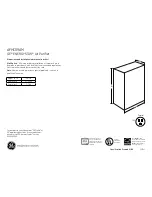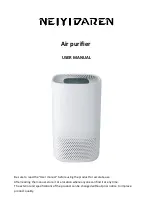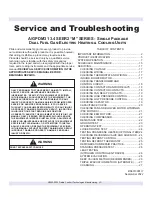
- 93 -
6832
6833
1) Total capacity of indoor units in the
same refrigerant system exceeds
the following:
2) Erroneous setting of OC model se-
lector switch (SW3-10).
Check
code
7100
Meaning, detecting method
Cause
Checking method & Countermeasure
Total capacity error
Total capacity of indoor units in
the same refrigerant system ex-
ceeds limitations.
Trouble source:
Outdoor unit
a) Chec
6831
k for the model total (capacity cord total) of
indoor units connected.
b) Check whether indoor unit capacity code (SW2)
is wrongly set.
For erroneous switch setting, modify it, turn off
power source of outdoor unit, and indoor unit
simultaneously for 5 minutes or more to modify
the switch for setting the model name (capacity
coad).
Check for the model selector switch (Dip switches
SW3-10 on outdoor unit control circuit) of OC.
Total capacity Total capacity code
325
65
1
ON
OFF
2 3 4 5
SW3
6 7 8 9 10
MA communication no-recep-
tion error
Problem with the communica-
tion between MA remote con-
trollers and indoor units
No instance of successful re-
ception of data in a 3-minute
period.
6834
MA communication, start but
detection error
Problem with the communica-
tion between MA remote con-
trollers and indoor units.
No instance of successful re-
ception of signals in a 2-minute
period.
MA communication, sync re-
storation error
Problem with the communica-
tion between MA remote con-
trollers and indoor units.
Failure to detect opening in the
transmission path and the sig-
nal could not be sent.
Indoor unit: for 3 minutes
Remote controller: for 6 minutes
MA communication, trans-
mission-reception H/W error
Problem with the communica-
tion between MA remote con-
trollers and indoor units.
Then transmitted data and re-
ceived data that are collected at
the same time differs 30 times
in a row.
1) Contact failure of MA remote con-
troller or indoor unit remote con-
troller wiring.
2) All the remote controllers are set to
“Sub”.
3) Failure to meet wiring specifica-
tions
1
Wire length
2
Wire diameter
3
Number of remote controllers
4
Number of indoor units
4) Remote controller was connected
and then removed without power
reset.
5) Noise interference on the remote
controller transmission channel.
6) Problems with the remote control-
ler transmission/reception circuit in
the indoor unit.
7) Problems with the transmission/re-
ception circuit in the remote con-
troller.
1) Contact failure of MA remote con-
troller or indoor unit remote con-
troller wiring.
2) More than 1 “Main” remote controller
3) Multiple indoor unit address
4) Noise interference in the remote
controller line.
5) Failure to meet wiring specifica-
tions.
1
Wire length
2
Wire diameter
3
Number of remote controllers
4
Number of indoor units
6) Problems with the transmission/re-
ception circuit in the remote con-
troller.
a) Check for loose or disconnected indoor unit or
MA remote controller transmission lines.
b) Confirm that the power is fed to main power
supply and remote controller line.
c) Confirm that MA remote controller’s maximum
capacity is not exceeded.
d) Check the Main/Sub setting of the MA remote
controller; one of must be set to sub.
e) Diagnose the remote controller (described on
the remote controller IM)
Results
[OK] : No problems with the remote control-
ler (check the wiring rules)
[NO] : Replace the remote controller
[6832, 6833, ERROR] : Noise interference
(Go to item f) )
f) Check the transmission wave patterns of and
interference in the MA remote controller trans-
mission signal. Refer to section
4
Transmis-
sion Wave Pattern and Noise Check.
g) When no problems were found in items a)
through f), replace the indoor controller board
or the MA remote controller
The following information can be obtained
from LED1 and 2 on the indoor controller
board:
LED1 is on : Main switch of the indoor unit
is on.
LED2 is on : MA remote controller line is
being powered.
[3] System error
















































